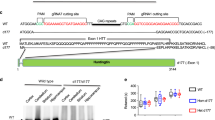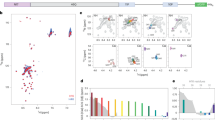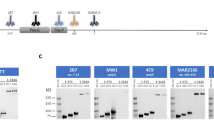Abstract
A POLYGLUTAMINE expansion (encoded by a CAG repeat) in specific proteins causes neurodegeneration in Huntington's disease (HD) and four other disorders1–6, by an unknown mechanism thought to involve gain of function or toxicity of the mutated protein7,8. The pathological threshold is 37–40 glutamines in three of these diseases, whereas the corresponding normal proteins contain polymorphic repeats of up to about 35 glutamines1–3. The age of onset of clinical manifestations is inversely correlated to the length of the polyglutamine expansion. Here we report the characterization of a monoclonal antibody that selectively recognizes polyglutamine expansion in the proteins implicated in HD and in spinocerebellar ataxia (SCA) 1 and 3. The intensity of signal depends on the length of the polyglutamine expansion, and the antibody also detects specific pathological proteins expected to contain such expansion, in SCA2 and in autosomal dominant cere-bellar ataxia with retinal degeneration, whose genes have not yet been identified9–13.
This is a preview of subscription content, access via your institution
Access options
Subscribe to this journal
Receive 51 print issues and online access
$199.00 per year
only $3.90 per issue
Buy this article
- Purchase on Springer Link
- Instant access to full article PDF
Prices may be subject to local taxes which are calculated during checkout
Similar content being viewed by others
References
La Spada, A. R., Wilson, E. M., Lubahn, D. B., Harding, A. E. & Fischbeck, K. H. Nature 352, 77–79 (1991).
The Huntington's Disease Collaborative Research Group Cell 72, 971–983 (1993).
Orr, H. T. et al. Nature Genet. 4, 221–226 (1993).
Koide, R. et al. Nature Genet. 6, 9–13 (1994).
Nagafuchi, S. et al. Nature Genet. 6, 14–18 (1994).
Kawaguchi, Y. et al. Nature Genet. 8, 221–228 (1995).
Housman, D. Nature Genet. 10, 3–4 (1995).
Albin, R. L. & Tagle, D. A. Trends Neurosci. 18, 11–14 (1995).
Benomar, A. et al. Nature Genet. 10, 84–88 (1995).
Gouw, L. G. et al. Nature Genet. 10, 89–93 (1995).
Gispert, S. et al. Nature Genet. 4, 295–299 (1993).
Belal, S. et al. Neurology 44, 1423–1426 (1994).
Pulst, S.-M., Nechiporuk, A. & Starkman, S. Nature Genet. 5, 8–10 (1993).
Gerber, H. P. et al. Science 263, 808–811 (1994).
Imbert, G., Trottier, Y., Beckmann, J. & Mandel, J.-L. Genomics 21, 667–668 (1994).
Gostout, B., Liu, Q. & Sommer, S. S. Am. J. hum. Genet. 52, 1182–1190 (1995).
Lescure, A. et al. EMBO J. 13, 1166–1175 (1994).
Trottier, Y. et al. Nature Genet. 10, 104–110 (1995).
Dürr, A. et al. Brain (in the press).
Gardner, K. et al. Neurology 44, A361 (1994) (Abstract).
Ranum, L. P. W., Schut, L. J., Lundgren, J. K., Orr, H. T. & Livingston, D. M. Nature Genet. 8, 280–284 (1994).
Gispert, S. et al. Am. J. hum. Genet. 56, 183–187 (1995).
Hazan, J. et al. Hum. molec. Genet. 3, 1569–1573 (1994).
Hazan, J. et al. Nature Genet. 5, 163–167 (1993).
Ross, C. A., Mclnnis, M. G., Margolis, R. L. & Li, S.-H. Trends Neurosci. 16, 254–260 (1993).
Stott, K., Blackburn, J. M., Butler, P. J. G. & Perutz, M. Proc. natn. Acad. Sci. U.S.A. 92, 6509–6513 (1995).
Trottier, Y., Biancalana, V. & Mandel, J.-L. J. med. Genet. 31, 377–382 (1994).
Servadio, A. et al. Nature Genet. 10, 94–98 (1995).
Sittler, A., Devys, D., Weber, C. & Mandel, J.-L. Hum. molec. Genet. (in the press).
Lee, K. A. W., Bindereif, A. & Green, M. R. Gene analyt. Techn. 5, 22–31 (1988).
Lezin, A. et al. Hum. Genet. (in the press).
Author information
Authors and Affiliations
Rights and permissions
About this article
Cite this article
Trottier, Y., Lutz, Y., Stevanin, G. et al. Polyglutamine expansion as a pathological epitope in Huntington's disease and four dominant cerebellar ataxias. Nature 378, 403–406 (1995). https://doi.org/10.1038/378403a0
Received:
Accepted:
Published:
Issue Date:
DOI: https://doi.org/10.1038/378403a0
This article is cited by
-
Huntington disease-like 2: insight into neurodegeneration from an African disease
Nature Reviews Neurology (2024)
-
Repressor Element-1 Binding Transcription Factor (REST) as a Possible Epigenetic Regulator of Neurodegeneration and MicroRNA-Based Therapeutic Strategies
Molecular Neurobiology (2023)
-
The distribution and density of Huntingtin inclusions across the Huntington disease neocortex: regional correlations with Huntingtin repeat expansion independent of pathologic grade
Acta Neuropathologica Communications (2022)
-
Polyglutamine-expanded ATXN7 alters a specific epigenetic signature underlying photoreceptor identity gene expression in SCA7 mouse retinopathy
Journal of Biomedical Science (2022)
-
Human Induced Pluripotent Stem Cell-Based Modelling of Spinocerebellar Ataxias
Stem Cell Reviews and Reports (2022)
Comments
By submitting a comment you agree to abide by our Terms and Community Guidelines. If you find something abusive or that does not comply with our terms or guidelines please flag it as inappropriate.



